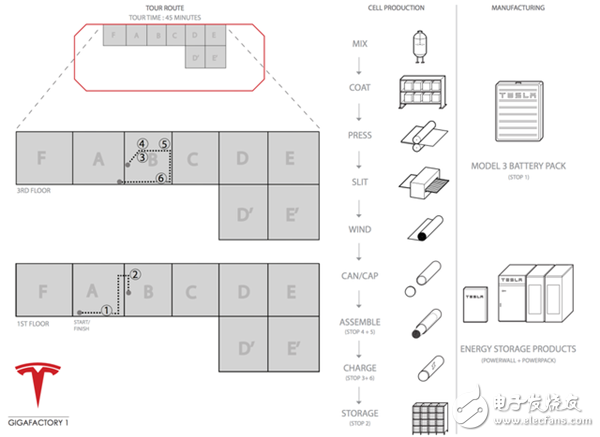Tesla held an investor meeting last week at its Gigafactory, a super factory in Nevada. Now, the company has released more information about the Gigafactory factory. Earlier media reports said that Tesla officially disclosed that its battery production line has entered mass production during this investor meeting. Tesla CEO Elon Musk also expressed his views on the potential changes in Trump's position in the renewable energy sector.
Tesla has now released more details about its first Gigafactory plant (GF1). Before investors visited the factory's battery production line, Tesla also introduced them to its new Gigafactory plant, the world's largest solar roof array.
Here are some details:
Since the announcement of the Gigafactory plant project, Tesla has claimed that the plant will not use any fossil fuels in the future, but instead will use fossil fuels instead of renewable energy – relying mainly on solar arrays to provide energy.

Now, the company confirms that the Gigafactory plant will have rooftop solar arrays and ground-based solar facilities. Tesla said in an introduction to investors that the 70MW rooftop solar array will be the world's largest solar power installation.
Tesla said: "The first Gigafactory plant will be a manufacturing plant that does not use fossil fuels (natural gas or oil) and relies entirely on electrical energy. Through a 70MW rooftop solar array and solar floor facilities, we will be 100% The use of sustainable energy. The new rooftop solar array system has more than seven times the size of the world's largest solar array system.
Currently, the largest rooftop solar array in use in the United States is the regional distribution center from Whirlpool Corpora TIon, Calif., with a capacity of 10 MW. Another larger solar array comes from India with a capacity of 11.5 MW. For the 70MW capacity, both solar array facilities belong to the pediatrics.
Tesla also revealed specific details of its climate control system, water treatment system and battery recycling system at its Gigafactory plant:
“Because the plant uses all electrical energy, it is more efficient and achieves the goal of zero carbon emissions. The waste heat recovered during the production process can meet the heating requirements of most buildings. The closed circuit water circulation system owned by the Gigafactory plant uses 6 A variety of highly efficient circulating water treatment systems provide approximately 1.5 million liters of water per hour to the plant. The new system reduces the use of new water by nearly 80% compared to standard water treatment processes. The construction site is currently The built-in battery recycling system will be able to safely recycle all types of Tesla's used batteries, battery modules and battery packs in the future, and the recovered metals can continue to be used in the manufacture of new batteries."
In the documents provided to investors, Tesla detailed the production process of battery products. It is also disclosed that a company from Germany has also been in the Gigafactory factory and is engaged in the manufacture of battery casing products.
Interestingly, Tesla apparently “stopped†the introduction of the “Model 3 electric vehicle battery pack†in the documents provided during the investor's reference period.
It is unclear what details investors have seen during this visit, but Tesla is likely to show them for the first time the battery packs used in their upcoming Model 3 electric vehicles. It is not clear at this time whether Tesla's battery pack is used for its energy storage products Powerwall or Powerpack.
Last week, the electric vehicle manufacturer confirmed to the outside world that it plans to start producing the battery packs needed for the Model 3 electric car in the second quarter of 2017.
According to Tesla's original plan, the battery capacity of the first Gigafactory plant will reach 35GWh, and the capacity of the battery pack will reach 50 GWh. But the company is now adjusting its initial capacity targets and plans to reach the above capacity in 2018. In addition, it is planned to increase the overall capacity of the Gigafactory plant to more than three times its current target by around 2020.
In the documents provided to investors, Tesla explained how it succeeded in reducing the investment cost per GWh unit of the Gigafactory plant and how to achieve growth:
1. Increase the production density of production facilities and accelerate production capacity;
2. Interior design and construction methods;
3. Complete and comprehensive facility system, equipment design, layout and implementation method;
4. Innovative building construction technology can effectively reduce land occupation area, building and infrastructure area, as well as construction materials and labor costs.
Tesla also offers the following measures for the reduction in production costs per kWh of battery and battery pack:
1. Coordinate the production methods to reduce the amount of taxation and input costs (raw materials, components, labor, energy and water);
2. Re-engineering all supply chains to achieve higher efficiency capacity scales and tailored component needs while reducing transportation costs;
3. Improve the design content of the battery product, improve the battery energy density level, and optimize the battery size (2170 vs 18650);
4. Improve the battery module and battery pack design content, and improve the energy density level of the battery pack;
5. Improve automation and process design content to increase production. Reduce the cost of waste and improve on-site reliability;
6. Reduce the capital invested per GWh of production capacity and reduce the depreciation expense.
The open frame industrial monitor that we offer are a range of monitors without front bezel--all kits: TFT LCD panel (touchscreen), LCD controller board, inverter and cables mounting into a back enclosure. It is low profile design, suit for self-mounting into kiosks, cabinets, consoles, machines and control panels. This monitor is ideal for integrators and OEMs for special mounting applications.
open frame monitor,open frame lcd monitors,open frame touch screen,open frame youch monitor,open frame displays,open frame lcd display
Shenzhen Hengstar Technology Co., Ltd. , https://www.angeltondal.com